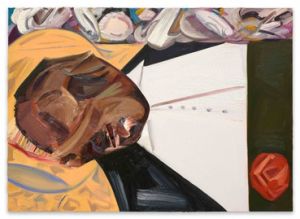Open Casket
Open Casket is a painting made in 2016 by Dana Schutz. The subject in the painting is a 14 year old boy named Emmett Till who was lynched by two white men in Mississippi in 1955. This artwork was included at the 2017 Whitney Biennial exhibition in New york curated by christopher Y. Lew and Mia Locks. [1]
Background
The painting was made by Dana schutz in August 2016 in response to media coverage of gun violance to a black man from police. The potrait is based on a photograph of Till's mutilated body-- where his mother insisted for the casket to remain be opened, to raise awareness of the graphic realities of racism in the U.S. that was published in The Chicago Defender and Jet magazine. "The photograph of Emmett Till felt analogous to the time: what was hidden was now revealed" Schutz told in Artnet. [2]
Controversy
Short after the publicity in the opening of 2017 Whitney Biennial. The painting caused controversy within the protest and calls for painting's destruction. Hannah Black who is an artist and a writer, posted an open letter to the museum's curators and staff to Facebook that saying:
"I am writing to ask you to remove Dana Schutz's painting Open Casket with the urgent recommendation that the painting be destroyed and not entered into any market or museum. As you know, this painting depicts the dead body of 14-year-old Emmett Till in the open casket that his mother chose, saying, 'Let the people see what I've seen.' That even the disfigured corpse of a child was not sufficient to move the white gaze from its habitual cold calculation is evident daily and in a myriad of ways, not least the fact that this painting exists at all. In brief: The painting should not be acceptable to anyone who cares or pretends to care about Black people because it is not acceptable for a white person to transmute Black suffering into profit and fun .."
The act led to a conversation in the media on cultural appropriation by white artist. On the comment about how and why the painting was made, Schutz responded:
"I don't know what it is like to be black in America but I do know what it is like to be a mother. Emmett was Mamie Till's only son. The thought of anything happening to your child is beyond comprehension. Their pain is your pain. My engagement with this image was through empathy with his mother. ... Art can be a space for empathy, a vehicle for connection. I don't believe that people can ever really know what it is like to be someone else (I will never know the fear that black parents may have) but neither are we all completely unknowable."
Schutz argued that the painting is different than the original photograph. He explained that the painting was created on the account of hearing Mamie Till's comment upon seeing her son. Schutz reportedly said, "The photograph of him in his casket is almost impossible to look at. In making the painting, I relied more on listening to Mamie Till's verbal account of seeing her son, which oscillates between memory and observation." On another occasion Schutz also said: "The painting is very different from the photograph. I could never render the photograph ethically or emotionally."
In April 2017, the Whitney Museum partnered with Claudia Rankine and the Racial Imaginary Institute to host "Perspectives on Race and Representation," to address the debate sparked by the painting.[3]
In November 2017, the painting and the surrounding issues were discussed on BBC Radio 4's Analysis.
